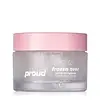What's inside
What's inside
 Key Ingredients
Key Ingredients

 Benefits
Benefits

 Concerns
Concerns

 Ingredients Side-by-side
Ingredients Side-by-side

Hydroquinone 2%
StabilisingWater
Skin ConditioningButylene Glycol
HumectantCaprylic/Capric Triglyceride
MaskingGlycerin
HumectantHydroxyethyl Acrylate/Sodium Acryloyldimethyl Taurate Copolymer
Emulsion StabilisingSalicylic Acid
MaskingKojic Acid
AntioxidantSqualane
EmollientPhenoxyethanol
PreservativeNiacinamide
SmoothingXanthan Gum
EmulsifyingSodium Metabisulfite
AntioxidantEthylhexylglycerin
Skin ConditioningSodium Hyaluronate
HumectantWater
Skin ConditioningPropanediol
SolventGlycerin
Humectant1,2-Hexanediol
Skin ConditioningButylene Glycol
HumectantSodium Polyacrylate Starch
AbsorbentAmmonium Acryloyldimethyltaurate/Vp Copolymer
Sodium Carbomer
Emulsion StabilisingCitrus Limon Fruit Extract
MaskingEthylhexylglycerin
Skin ConditioningMenthoxypropanediol
MaskingAloe Barbadensis Leaf Juice
Skin ConditioningNymphaea Alba Flower Extract
Skin ConditioningDisodium EDTA
Hyaluronic Acid
HumectantHydrolyzed Hyaluronic Acid
HumectantSodium Hyaluronate
HumectantAkebia Quinata Extract
Skin ConditioningPhenoxyethanol
PreservativeBetula Platyphylla Japonica Juice
Skin ConditioningChamaecyparis Obtusa Water
MaskingPhyllostachys Bambusoides Juice
Skin ConditioningCymbopogon Schoenanthus Extract
Skin ConditioningCitrus Aurantifolia Peel Extract
CleansingMentha Rotundifolia Leaf Extract
TonicAllantoin
Skin ConditioningBetula Alba Juice
AstringentInonotus Obliquus Extract
Skin ConditioningXylitol
HumectantTocopherol
AntioxidantWater, Propanediol, Glycerin, 1,2-Hexanediol, Butylene Glycol, Sodium Polyacrylate Starch, Ammonium Acryloyldimethyltaurate/Vp Copolymer, Sodium Carbomer, Citrus Limon Fruit Extract, Ethylhexylglycerin, Menthoxypropanediol, Aloe Barbadensis Leaf Juice, Nymphaea Alba Flower Extract, Disodium EDTA, Hyaluronic Acid, Hydrolyzed Hyaluronic Acid, Sodium Hyaluronate, Akebia Quinata Extract, Phenoxyethanol, Betula Platyphylla Japonica Juice, Chamaecyparis Obtusa Water, Phyllostachys Bambusoides Juice, Cymbopogon Schoenanthus Extract, Citrus Aurantifolia Peel Extract, Mentha Rotundifolia Leaf Extract, Allantoin, Betula Alba Juice, Inonotus Obliquus Extract, Xylitol, Tocopherol
Ingredients Explained
These ingredients are found in both products.
Ingredients higher up in an ingredient list are typically present in a larger amount.
Butylene Glycol (or BG) is used within cosmetic products for a few different reasons:
Overall, Butylene Glycol is a safe and well-rounded ingredient that works well with other ingredients.
Though this ingredient works well with most skin types, some people with sensitive skin may experience a reaction such as allergic rashes, closed comedones, or itchiness.
Learn more about Butylene GlycolEthylhexylglycerin (we can't pronounce this either) is commonly used as a preservative and skin softener. It is derived from glyceryl.
You might see Ethylhexylglycerin often paired with other preservatives such as phenoxyethanol. Ethylhexylglycerin has been found to increase the effectiveness of these other preservatives.
Glycerin is already naturally found in your skin. It helps moisturize and protect your skin.
A study from 2016 found glycerin to be more effective as a humectant than AHAs and hyaluronic acid.
As a humectant, it helps the skin stay hydrated by pulling moisture to your skin. The low molecular weight of glycerin allows it to pull moisture into the deeper layers of your skin.
Hydrated skin improves your skin barrier; Your skin barrier helps protect against irritants and bacteria.
Glycerin has also been found to have antimicrobial and antiviral properties. Due to these properties, glycerin is often used in wound and burn treatments.
In cosmetics, glycerin is usually derived from plants such as soybean or palm. However, it can also be sourced from animals, such as tallow or animal fat.
This ingredient is organic, colorless, odorless, and non-toxic.
Glycerin is the name for this ingredient in American English. British English uses Glycerol/Glycerine.
Learn more about GlycerinPhenoxyethanol is a preservative that has germicide, antimicrobial, and aromatic properties. Studies show that phenoxyethanol can prevent microbial growth. By itself, it has a scent that is similar to that of a rose.
It's often used in formulations along with Caprylyl Glycol to preserve the shelf life of products.
Sodium Hyaluronate is hyaluronic acid's salt form. It is commonly derived from the sodium salt of hyaluronic acid.
Like hyaluronic acid, it is great at holding water and acts as a humectant. This makes it a great skin hydrating ingredient.
Sodium Hyaluronate is naturally occurring in our bodies and is mostly found in eye fluid and joints.
These are some other common types of Hyaluronic Acid:
Learn more about Sodium HyaluronateWater. It's the most common cosmetic ingredient of all. You'll usually see it at the top of ingredient lists, meaning that it makes up the largest part of the product.
So why is it so popular? Water most often acts as a solvent - this means that it helps dissolve other ingredients into the formulation.
You'll also recognize water as that liquid we all need to stay alive. If you see this, drink a glass of water. Stay hydrated!
Learn more about Water